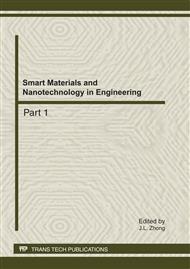[1]
S. Wold, L. Eriksson, S. Hellberg, et al., Principal property values for six non-natural amino acids and their application to a structure-activity relationship for oxytocin peptide analogues, Can. J. Chem., 1987, 65, pp.1814-1820.
DOI: 10.1139/v87-305
Google Scholar
[2]
C. Raychaudhury, A. Banerjee, P. Bag, et al., Topological shape and size of peptides: Identification of potential allele specific helper T cell antigenic sites, J. Chem. Inf. Comp. Sci., 1999, 39, pp.248-254.
DOI: 10.1021/ci980052w
Google Scholar
[3]
S.S. Liu, C. S. Yin, Z. L. Li, et al., A novel MHDV descriptor for dipeptide QSAR studies, J. Chin. Chem. Soc., 2001, 48, pp.253-260.
DOI: 10.1002/jccs.200100041
Google Scholar
[4]
P.H. Sneath, Relations between chemical structure and biological activity in peptides, J. Theor. Biol., 1966, 12, pp.157-195.
Google Scholar
[5]
A. Kidera, Y. Konishi, M. Oka, et al., A statistical analysis of the physical properties of the 20 naturally occuring amino acids, J. Protein Chem., 1985, 4, pp.23-55.
DOI: 10.1007/bf01025492
Google Scholar
[6]
S. Hellberg, L. Eriksson, J. Jonsson, et al., Minimum analogue peptide sets (MAPS) for quantitative structure-activity relationships, Int. J. Pept. Protein Res., 1991, 37, pp.414-424.
DOI: 10.1111/j.1399-3011.1991.tb00756.x
Google Scholar
[7]
S. Hellberg, M. Sjostrom, B. Skagerberg, et al., Peptide quantitative structure-activity relationships, a multivariate approach, J. Med. Chem., 1987, 30, pp.1126-1135.
DOI: 10.1021/jm00390a003
Google Scholar
[8]
S. Hellberg, M. Sjostrom, S. Wold, The prediction of bradykinin potentiating potency of pentapeptides: An example of a peptide quantitative structure-activity relationship, Acta Chem. Scand., 1986, 40, pp.135-140.
DOI: 10.3891/acta.chem.scand.40b-0135
Google Scholar
[9]
J. Jonsson, L. Eriksson, S. Hellberg, et al., Multivariate parameterization of 55 coded and non-coded amino acids. Quantitative Structure-Activity Relationship, 1989, 8, p.204–209.
DOI: 10.1002/qsar.19890080303
Google Scholar
[10]
M. Sandberg, L. Eriksson, J. Jonsson, et al., New chemical descriptors for the design of biologically active peptides: A multivariate charater-rization of 87 amino acids, J. Med. Chem., 1998, 41, pp.2481-2491.
DOI: 10.1021/jm9700575
Google Scholar
[11]
E.R. Collantes, W.J. Dunn, Amino acid side chain descriptors for quantitative structure-activity relationship studies of peptide analogues, J. Med. Chem., 1995, 38, pp.2705-2713.
DOI: 10.1021/jm00014a022
Google Scholar
[12]
A. Zaliani, E. Gancia, MS-WHIM scores for amino acids: a new 3Ddescription for peptide QSAR and QSPR studie, J. Chem. Inf. and Comp. Sci., 1999, 39, p.525–533.
DOI: 10.1021/ci980211b
Google Scholar
[13]
H. Mei, Z.H. Liao, Y. Zhou, et al., A new descriptor of amino acids and its application in peptide QSARs, Biopolymers(pept. Sci. ), 2005, 80(6), p.775–786.
DOI: 10.1002/bip.20296
Google Scholar
[14]
F.F. Tian, P. Zhou, Z.L. Li, T-Scale as a novel vector of topological descriptors for amino acids and its application in QSARs of peptides, J. Mol. Struc. -THEOCHEM, 2007, 830, p.106–115.
DOI: 10.1016/j.molstruc.2006.07.004
Google Scholar
[15]
J.B. Tong, S.L. Liu, P. Zhou, et al., A novel descriptor of amino acids and its application in peptide QSAR, J. Theor. Biol., 2008, 253, pp.90-97.
DOI: 10.1016/j.jtbi.2008.02.030
Google Scholar
[16]
M.S. Venkatarajan, W. Braun, New quantitative descriptors of amino acids based on multidimensional scaling of a large number of physical–chemical properties, J. Mol. Model., 2001, 7, pp.445-453.
DOI: 10.1007/s00894-001-0058-5
Google Scholar
[17]
A M. sao, H. Iwamara, M. Akamatsu, et al., Quantitative structure–activity relationships of bitter thresholds of amino acids, peptides and their derivatives, J. Med. Chem., 1987, 30(10), p.1873–1879.
DOI: 10.1021/jm00393a031
Google Scholar
[18]
E L. riksson, E. Johansson, N. Kettaneh-Wold, et al., Multi- and megavariate data analysis: principle and application, Umea, Sweden: Umetrics AB, (2001).
Google Scholar
[19]
M. Cocchi, E. Johansson, Amino acids characterization by GRID and multivariate data analysis, Quant. Struc. -Act. Rel., 1993, 12, pp.1-8.
DOI: 10.1002/qsar.19930120102
Google Scholar
[20]
S.Z. Li, B.H. Fu, Y.Q. Wang, S.S. Liu, On structural parameterization and molecular modeling of peptide analogues by molecular electronegativity-edge vector (VMEE): estimation and prediction for biological activity of pentapeptides, J. Chin. Chem. Soc., 2001, 48, pp.937-944.
DOI: 10.1002/jccs.200100137
Google Scholar
[21]
P. Zhou, Y. Zhou, S.R. Wu, et al., A new descriptor of amino acids based on the three-dimensional vector of atomic interaction field, Chin. Sci. Bull. 2006, 51(5), pp.524-529.
DOI: 10.1007/s11434-006-0524-7
Google Scholar
[22]
G.Z. Liang, P. Zhou, Y. Zhou, et al., New descriptors of amino acids and their applications to peptide quantitative structure activity relationship, Acta Chim. Sin., 2006, 64(5), pp.393-396.
Google Scholar
[23]
Z.H. Lin, H.X. Long, Z. Bo, et al., New descriptors of amino acids and their application to peptide QSAR study, Peptides, 2008, 28, pp.1798-1805.
DOI: 10.1016/j.peptides.2008.06.004
Google Scholar


